Gayfeather (Liatris Spicata): Care, Growing Guide and Types (With Pictures)
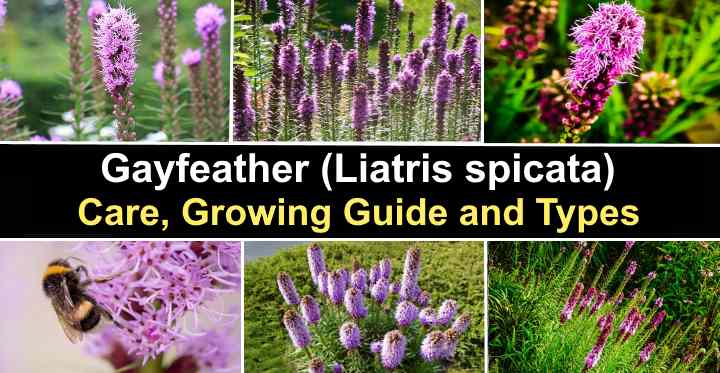
Gayfeather (Liatris spicata) is a flowering perennial plant with tall spikes of showy purple or white flowers. Also called blazing star or prairie star, Liatris spicata grows in clumps and prefers moist, marshy ground. Blazing star flower spikes grow between 1 and 5 ft. (0.3 – 1.5 m) tall. The impressive gayfeather flowers mean the plant is ideal for planting individually or mass planting along borders in full sun.
Gayfeather plants have immense ornamental value as easy-care, low-maintenance summer plants. Gayfeather (Liatris spicata) flowers bloom throughout the summer and may last until fall. The purple flower spikes look like wispy feathers on the end of pokers. Or, some say that flowers on a blazing star plant look like bottle brushes.
This article is a complete guide to growing gayfeather plants. At the end of the article, you’ll find out about some attractive blazing star (Liatris spicata) cultivars to grow in your backyard.
How to Care for Gayfeather (Liatris spicata)
To care for gayfeather, grow the blazing star plant in the sunniest part of your garden. Plant the gayfeather bulbs in light, well-draining, fertile soil. Water during dry spells to keep the ground moist. It is best to deadhead spent flowers to extend blooming. Gayfeather doesn’t need additional fertilizing.
Gayfeather (Blazing Star) Facts
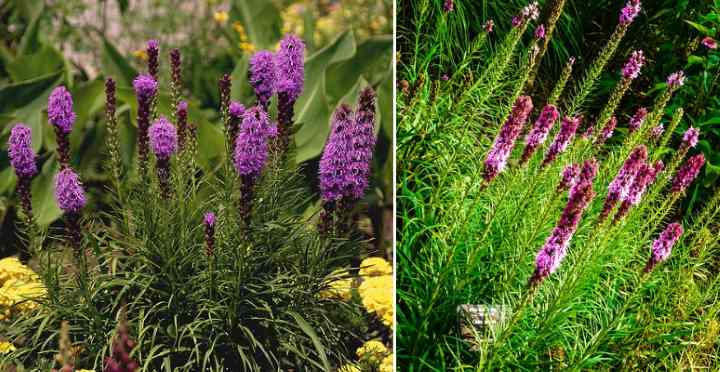
Liatris spicata (gayfeather or blazing star) flowers look beautiful especially when planted en masse
Gayfeather (Liatris spicata) belongs to the perennial flowering plant family Asteraceae. Native to eastern North America, gayfeather plants grow on prairies and meadows. The plant’s ornamental value makes it a beautiful garden flower to cultivate in your backyard.
Outdoors, gayfeather thrives in USDA zones 3 through 9. Although the plant prefers moist ground, it is relatively drought-tolerant and survives well in dry regions. Gayfeather also grows well in heat and humid conditions.
Other common names for gayfeather include ‘blazing star,’ ‘dense blazing star,’ ‘button snakewort,’ ‘spike gayfeather,’ and ‘Kansas gayfeather.’ However, some gardeners refer to the plant simply as Liatris.
The length of gayfeather’s flowering stems depends on the cultivar. For example, the gayfeather ‘Kobold’ with pink flowers grow around 1 – 2 ft. (30 – 60 cm) tall. The gayfeather ‘Alba’ with its white flowering spikes grows up to 3 ft. (1 m) high. However, the rough blazing star has light pink flowers and tall flower spikes growing up to 5 ft. (1.5 m) tall.
Gayfeather Flowers
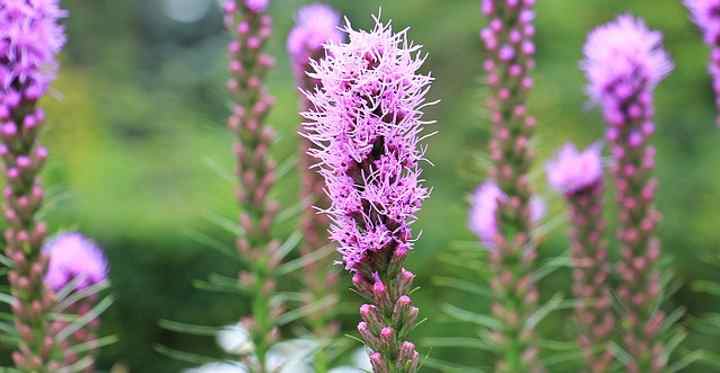
Gayfeather flower spikes can be purple, pink or white and look great in floral arrangements
Gayfeather flowers are spectacular when they bloom from July until September. The poker-like flower heads consist of florets made up from wispy petals. Close up, the vibrant purple, pink, or white flowers look like blazing stars. The flowering heads measure between 6” and 12” (15 – 30 cm) long.
The benefit of growing gayfeather flowers in your garden is that they attract pollinators. Butterflies, native bees, and hummingbirds are regular visitors to gayfeather plants when they’re in bloom.
Ornamental gayfeather flowers are beautiful in fresh cut or dried floral arrangements. Fresh cut gayfeather flowers last for up to two weeks in a vase of water. You can also dry gayfeather flowers to make the blooms last even longer. Hang the flowers upside down in a dark, dry place for three weeks to dry the flowers.
Before cutting flowers from gayfeather plants, it’s best to ensure that at least two-thirds of the flowering spike is in bloom.
Gayfeather (Liatris spicata) Growing Guide
Let’s look in more detail at how to grow gayfeather clumping perennial plants in your sunny backyard.
Where to Plant Gayfeather
The best place to plant gayfeather bulbs (also called corms) is in a location in your garden that gets plenty of sunshine. The planting location must have excellent drainage. Soggy conditions—especially in winter—can cause root rot.
You can plant gayfeather in mixed flower beds, flowering borders, cottage gardens, or informal flower gardens. Excellent companion plants for gayfeather are other tall flowering plants such as black-eyed Susan and echinacea. Gayfeather also grows well alongside ornamental grasses, daylilies, and other plants from the aster family.
Light Requirements for Growing Gayfeather Flowers
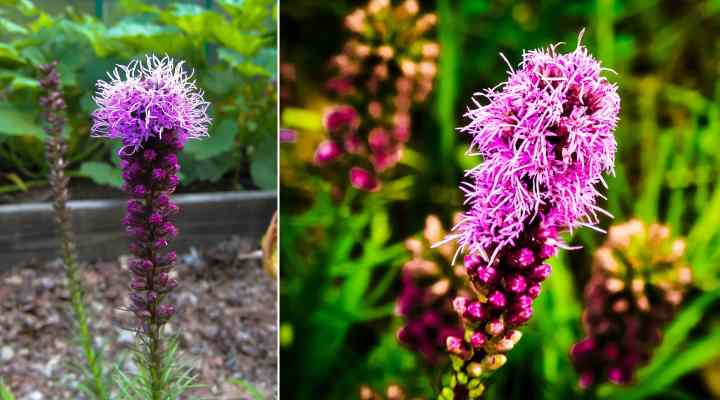
Gayfeather flowers grow best in full sun
Gayfeather flowers thrive in full sun and can withstand some partial shade. If your summer climate is hot and dry, then partial shade is best for gayfeather. Getting at least six to eight hours of sunshine daily encourages prolific blooming from midsummer until late fall.
You can also grow spike gayfeather in pots in your backyard as long as they get plenty of sunlight. The perennial flowers grow well in containers and are easy to care for. Growing gayfeather plants in pots is ideal for small, sunny gardens to decorate a patio or deck area.
The Best Soil for Growing Gayfeather
Gayfeather grows best in moist, fertile soil that has excellent drainage. You can get the ground conditions right by working in plenty of aged compost and peat moss to provide nutrients and retain moisture. Additionally, you can amend the soil with grit or perlite to increase drainage.
Being an easy-to-care-for garden perennial, spike gayfeather grows almost anywhere. Even in poor, dry soil, the hardy plant continues growing and flowering during summer. However, the plant’s growth is most vigorous when the soil conditions are ideal.
The crucial care aspect of growing gayfeather is to prevent the roots from sitting in waterlogged soil. Gayfeather plants grow from tuberous corms that store moisture. The overly soggy ground will cause root decay to set in and eventually kill the plant.
How to Water Gayfeather
After being established, gayfeather clumping plants only need occasional watering. It would be best if you watered the ground as often as necessary to prevent it from completely drying out. Generally, you can wait until the top 2” (5 cm) of soil is dry before thoroughly watering the plant.
During hot summer months, give the spike gayfeather about 1” (2.5 cm) of water weekly. This regular irrigation prevents leaf scorch and slow flower growth.
When watering gayfeather, it’s best to water the ground and avoid splashing water on the foliage. The watering technique helps prevent foliage fungal diseases such as powdery mildew.
After establishment, gayfeather is a relatively drought-tolerant perennial. Although Liatris spicata prefers moist soil, it will continue to grow in arid conditions.
Top care tip for gayfeather plants: Hold off watering during winter as wet, cold soil can cause Liatris spicata root rot.
Temperature and Humidity for Growing Gayfeather
Gayfeather plants are cold-hardy perennials that come back year after year. Gayfeather tuberous roots withstand the freezing temperatures in USDA zone 3 as low as -40°F (-40°C). During hot summers, gayfeather grows well in the heat and full sun—if it gets enough water.
Humidity is rarely a problem for gayfeather plants. However, it’s vital to ensure the plant has enough room to spread. Gayfeather has a spread of up to 15” (38 cm). Good air circulation keeps the plant healthy and prevents fungal issues from affecting the foliage.
Fertilizing Gayfeather
Gayfeather blazing stars are not heavy feeders if the soil is healthy. So, you probably don’t need to add any fertilizer for the plant to grow well. However, you can apply a high phosphorus water-soluble fertilizer in spring to encourage plenty of blooming throughout the season.
If you decide to apply fertilizer, use one with an NPK rating of 5-10-5. Additionally, you can work in some compost to the ground in spring to boost the soil’s nutrient content.
Pruning Gayfeather
The only pruning gayfeather plants need is to remove the conical flowers after blooming. Deadheading Liatris plants encourages more flowers to grow. This type of pruning sometimes keeps gayfeather flowering until late fall.
Here are some handy care tips for pruning gayfeather plants:
- Snip off faded blooms during summer to encourage flowering.
- After blooming has finished, you can cut the entire stalk at the plant’s base.
- You can prune the plant throughout the growing season to remove dead foliage.
- Don’t prune gayfeather stalks during fall. This encourages new growth that can get damaged in winter.
- After the gayfeather plant dies back to the ground, cut back foliage and dead flower stalks back. Leave about 4” (10 cm) above the ground.
- Or you can leave the flowering grass throughout winter and prune the plant to the ground in early spring.
Propagating Gayfeather
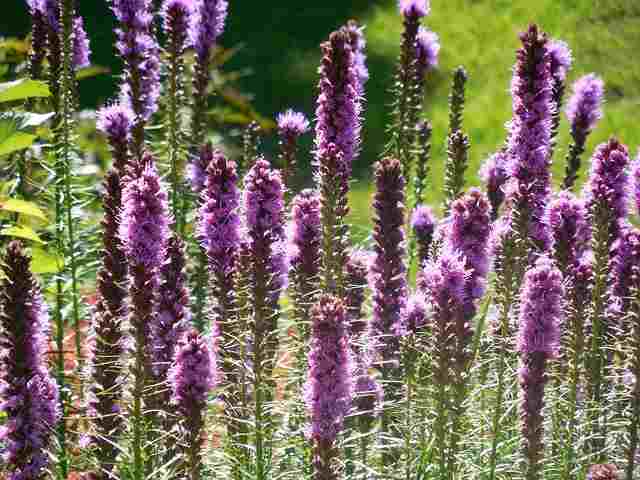
The best ways to propagate gayfeather plants is by root division and growing from seed
Root division and growing from seed are the primary ways to propagate gayfeather plants. Liatris spicata corms are easy to divide and then replant in loose, well-draining soil. You can also collect gayfeather seeds in the fall and plant them in the ground after cold exposure.
Propagating gayfeather plants by dividing the tuberous roots is easy to do in spring. First, you need to dig up the mass of bulbs from the ground carefully. Using a sharp, sterile knife, cut the roots into sections or break off baby corms. Each corm should have a few leaves on it.
To plant new gayfeather plants, space the bulbs 12” to 15” (30 – 38 cm) apart. Plant the bulbs about 3” (7.5 cm) deep.
It’s possible to propagate gayfeather by seed. However, the seeds need exposure to the cold and take a long time to germinate.
Top care tip to propagate gayfeather plants: Divide and replant gayfeather plants every few years to prevent overcrowding.
Replanting Gayfeather in Your Garden
To plant gayfeather in your backyard, work in about 2” (5 cm) of organic matter to the planting location. If necessary, amend the soil to improve drainage. Make a hole that’s slightly deeper than the root ball and twice as wide. Plant the corm, fill in the hole, and water thoroughly.
When planting gayfeather bulbs in your garden, it’s best to space them 12” to 15” (30 – 38 cm) apart. Giving the grassy plants plenty of space allows air to circulate freely and prevents various leaf fungal diseases.
Gayfeather plants require regular watering until they are established. But the good news is that gayfeather is a fast-growing plant and usually flowers in the first season after planting.
Managing Pests that Affect Gayfeather Growth
Plants in the Liatris species are generally resistant to pests. But the biggest threat to gayfeather plants is generally caterpillars. Larvae of the Liatris flower moth (Schinia sanguinea), rare glorious flower moth (Schinia gloriosa), and the Liatris borer moth (Carmenta anthracipennis) eat the flowers and sometimes the stems.
The best way to get rid of caterpillars from gayfeather plants is to hand pick them. Alternatively, you can turn a water hose on the plants to remove hungry, plant-destroying caterpillars.
Diseases Affecting Gayfeather Growth
Common diseases that affect gayfeather plants are powdery mildew, leaf spot, and root rot. To avoid plant diseases, it’s vital to ensure good air circulation and proper watering. Overly-damp, waterlogged ground causes the tuberous corms to decay. In time, fungal infections can start to cause the roots to rot.
When watering gayfeather plants, try to ensure that water doesn’t splash on the leaves. Dampness on leaves can cause fungal pathogens to spread on the foliage. The result can be a powdery white coating (powdery mildew) or darkened spots on the leaves (leaf spot).
Another way to prevent fungal disease is to make sure there’s plenty of air circulation. Ideally, gayfeather plant bulbs should be spaced apart at least 12” (30 cm) apart. In time, the plant grows and spreads further. Therefore, it’s necessary to divide the plant every few years to thin its growth.
Top care tip for gayfeather plants: If you have issues with fungal diseases, always wait until the ground’s surface is dry before watering.
Types of Gayfeather (Liatris spicata)
Gayfeather flowers are generally hues of purple colors. However, there are many Liatris species and cultivars that have vibrant pink or white flowers. Apart from Liatris spicata, there are also Liatris species such as aspera, pycnostachya, cylindracea, and ligulistylis.
The different varieties of gayfeather also come in different sizes. Some small gayfeather plants are ideal for growing in containers, whereas other tall plants are perfect for background flowers.
Here are some beautiful varieties of gayfeather plants:
Gayfeather ‘Alba’ (Liatris spicata ‘Alba’)—This white-flowered gayfeather plant grows up to 3 ft. (1 m) tall in full sun. The gayfeather ‘Alba’ flower spikes consist of feathery white flower tufts that give the flower head a fuzzy appearance.
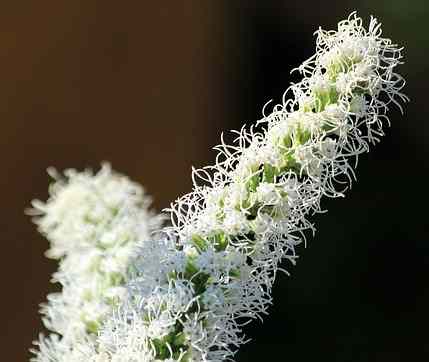
Liatris spicata ‘Alba’
Gayfeather ‘Kobold’ (Liatris spicata ‘Kobold’)—This clump-forming perennial has fluffy, conical bright purple flower heads growing on short flowering stalks. The Gayfeather ‘Kobold’ is a compact plant, ideal for growing in containers or small gardens.
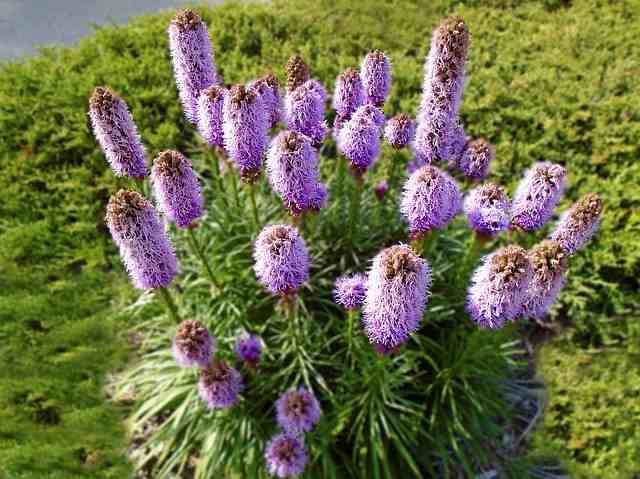
Listris spicata ‘Kobold’
Gayfeather ‘Floristan Weiss’ (Liatris spicata ‘Floristan Weiss’)—This tall ornamental gayfeather plant has long flowering white spikes. The showy, fluffy flowers grow in a slender conical shape and, like all Liatris species, bloom from top to bottom.
Rough blazing star (Liatris aspera)—One of the tallest Liatris plants, the Rough blazing star flowers are large pink tufts of feathery flowers. Rough blazing star pink flower spikes grow up to 5 ft. (1.5 m) high.
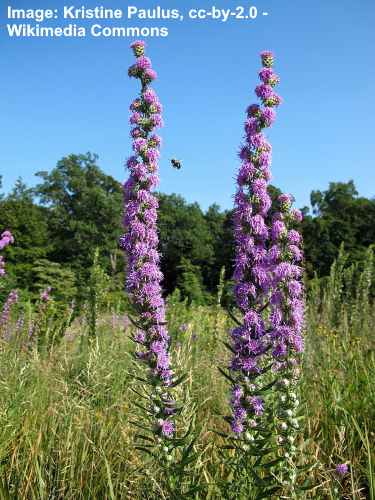
Rough blazing star (Liatris aspera)
Dotted gayfeather (Liatris punctata)—This attractive short gayfeather plant only grows 2 ft. (0.6 m) tall. The pink gayfeather flower heads are large tufts of wispy flowers. The dotted gayfeather plant is ideal for rock gardens, perennial borders, or growing in pots.
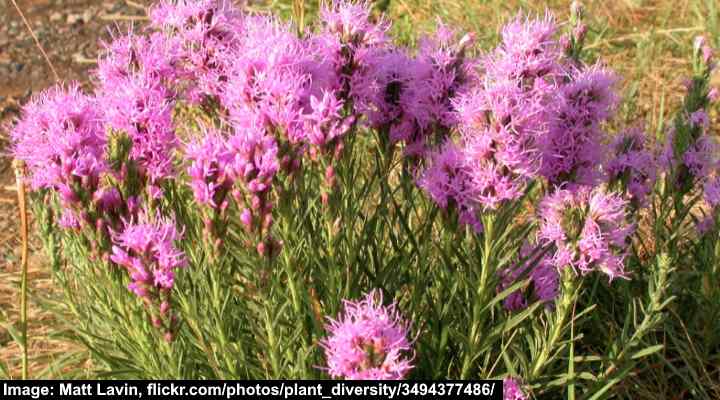
Dotted gayfeather (Liatris punctata)
Prairie blazing star (Liatris pycnostachya)—The prairie blazing star is another tall perennial flowering plant. This Liatris species has pink or purple long slender flower spikes consisting of flowers that look like blazing stars. The prairie blazing star grows between 2 and 5 ft. (0.6 – 1.5 m) tall.
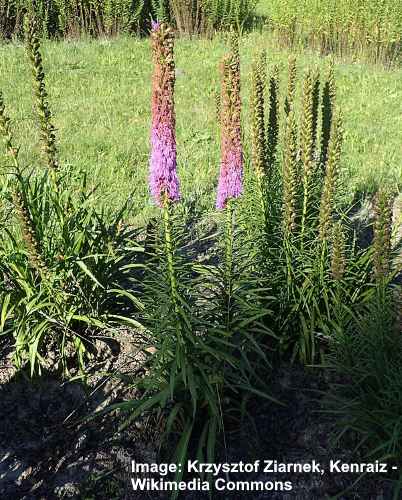
Prairie blazing star (Liatris pycnostachya)
Related articles:
